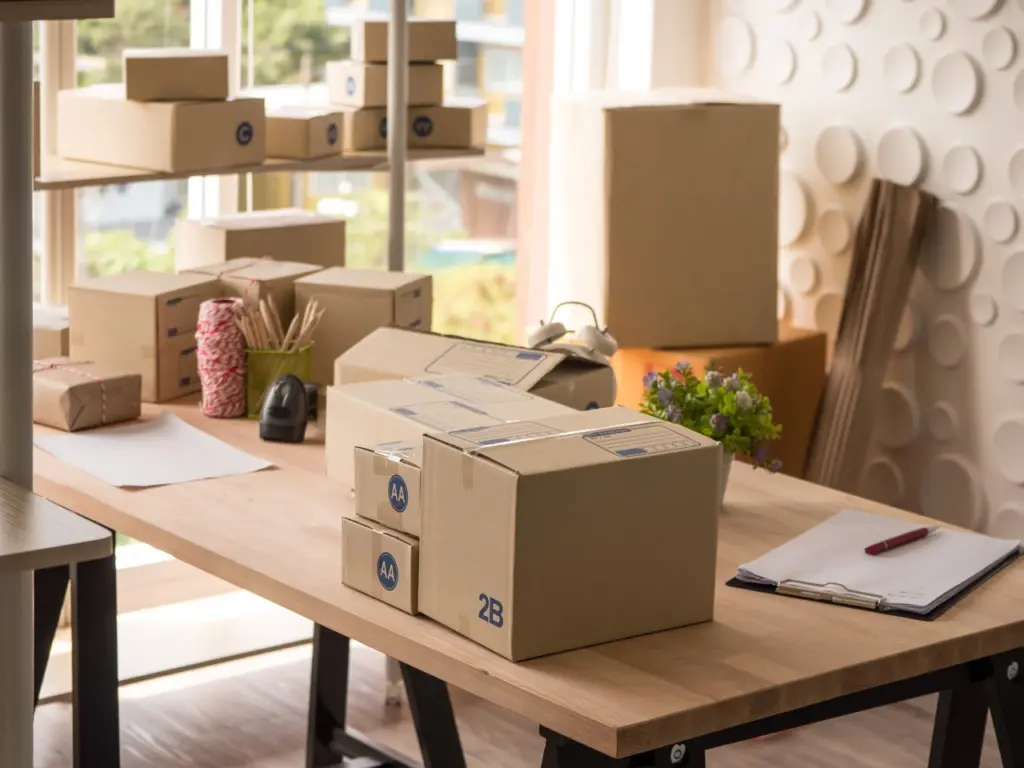Thinking about how to make your office relocation as smooth as possible? Relocating an office can be a complex task, involving everything from coordinating with moving companies to preparing a new office space.
Each step, from creating a moving checklist to managing the layout of your new location, plays a vital role in minimizing downtime and ensuring a successful office move.
In this article, we’ll offer an organized approach, covering everything from setting a moving date to hiring reliable relocation services. Whether you’re moving your office to a new workspace or expanding to a new office location, this comprehensive checklist will help you stay on track for a smooth transition.
Things Know Before Starting Your Office Relocation

Before initiating the office move, it’s crucial to know and understand the various elements that can significantly affect the success of your relocation.
An effective office move requires meticulous planning and preparing to minimize downtime and maintain your business operations seamlessly. By understanding these essential aspects, you can ensure a smooth transition to your ultimate office space.
1. Assess Your Current Office Space
Begin by thoroughly assessing your current office space. Conduct a detailed inventory of existing furniture and equipment to determine what can be relocated to the new office. Understanding your current office layout will help inform the design of your new office space, ensuring that it accommodates all office needs and supports productivity in the new environment.
2. Create a Detailed Office Move Checklist
Developing a comprehensive office move checklist is important for a successful office relocation. This checklist should outline all critical tasks, timelines, and responsibilities for your moving team. Key items to include are hiring professional moving companies, coordinating relocation services, establishing a moving date, and updating contact information to facilitate a smooth transition during the actual move.
3. Choose the Right Relocation Services
Choosing the right moving services is crucial for a seamless office move. Not all moving companies specialize in office relocations, so it’s essential to research and choose a mover with extensive experience in commercial moves. Look for relocation companies that offer comprehensive office relocation services to ensure a successful office move.
4. Plan Your New Office Layout
Planning your new office layout can significantly influence employee productivity and satisfaction. Collaborate with your team to design a workspace that encourages collaboration while meeting operational needs. Consider elements like workstation arrangements, visitor management, and communal areas to create an inviting and efficient environment in your new office.
5. Communicate the Move to Your Team
Effective communication about the office relocation is essential for a smooth transition. Inform your employees about the office move as early as possible, sharing details about the new office location and moving date. Keeping your team informed will help reduce anxiety and ensure that everyone is prepared for the changes during the relocation process.
6. Prepare for Downtime and Disruption
Anticipate potential downtime and disruptions during your office move. Scheduling the relocation during off-peak hours or on weekends can minimize impacts on your business operations. Ensure your team understands the moving process and is prepared for temporary interruptions, allowing for continued productivity during the transition.
7. Organize Your Office Supplies and Equipment
Before the move, organize your office supplies and equipment meticulously. A well-organized inventory will streamline the packing process and help prevent items from getting lost during the relocation. Use labeled boxes for different departments and types of office supplies, making unpacking in your new office more efficient.
8. Budget for Unexpected Costs
Establish a realistic budget that accounts for all potential costs associated with your office relocation. In addition to hiring moving companies, factor in expenses for new furniture, technology upgrades, and any necessary renovations in the new office space. A flexible budget will help manage unexpected costs and ensure a successful office move.
9. Consider the Logistics of Moving Day
Logistics play a critical role in ensuring a smooth moving day. Have a detailed plan outlining each step of the moving process, including packing, transportation, and unpacking. Assign roles to your team members, such as coordinating with the moving team or managing the setup in the new office. A clear plan will ensure an organized and efficient transition during the actual move.
10. Settle into Your New Office
Once the office relocation is complete, take time to settle into your new office environment. Ensure that all furniture and equipment are set up and functioning correctly, creating a welcoming workspace that helps your team feel comfortable. Engaging employees in the new office layout can foster a positive atmosphere, enhancing productivity and teamwork in the new space.
How to Create a Detailed Office Move Checklist

A comprehensive office move checklist is important to ensure a smooth transition when relocating your office. This guide will help you manage the moving process efficiently, allowing you to settle into your new office with minimal disruption to your business operations. By following these office relocation tips, you can streamline the moving process and position your company for success in its new space.
Establish Your Office Move Timeline
To kickstart your moving plan, establishing a clear timeline is a must. Outline key milestones from the initial planning phase to the actual moving day. Here are some factors to consider:
- Start Date: Determine when the office relocation process will begin.
- Moving Date: What is the target date for moving to a new location?
- Packing Deadlines: When should packing be completed to avoid last-minute chaos the week before the move?
Inventory Your Current Office Space
Conducting a complete inventory of your existing office space is a crucial step in planning an office relocation. This approach allows you to evaluate what office furniture and equipment can be moved and what needs to be replaced or discarded. Key points include:
- Existing Furniture and Equipment: Make a list of items you plan to take to your new office. Consider how each desk and workstation will fit into the new office setup.
- Office Supplies: Take stock of supplies that need to be ordered or replenished before the move to ensure you’re fully stocked upon arrival.
Hire Professional Moving Services
Choosing the right movers is vital for a successful office move. Research and hire moving companies that specialize in business relocation. Include the following in your checklist:
- Get Quotes: Request estimates from multiple moving companies and ensure they specialize in office relocations.
- Check References: Look for movers that offer commercial office relocation services and check their reviews to gauge their reliability.
Create a Packing Plan
A well-organized packing plan is essential for a smooth moving process. Include these steps in your office move checklist:
- Label Boxes: Clearly label each box with its contents and the destination in the new office to facilitate unpacking.
- Pack by Department: Organize the packing process by department, making it easier to arrange furniture and equipment in the new office layout.
Plan the New Office Layout
Before moving to a new office, it’s crucial to design a functional floor plan that promotes productivity. Consider the following:
- Workspace Configuration: Determine how workstations, meeting rooms, and communal areas will be arranged in the new space to optimize workflow.
- Visitor Management: Ensure the new office design accommodates visitor traffic and provides a welcoming environment for suppliers and customers.
Notify Employees and Stakeholders
Effective communication is important during an office relocation. Ensure everyone involved is informed about the move. Your checklist should include:
- Employee Announcement: Inform your team about the company’s moving plans and provide updates on the timeline.
- Stakeholder Communication: Notify suppliers and customers of your new office address and any changes in contact information.
Address Technology and IT Needs
Ensuring your technology is ready for the new office is a key element of your moving plan. Include the following tasks in your checklist:
- IT Assessment: Evaluate your current IT setup and determine what needs to be relocated or upgraded for your new office environment.
- Data Backup: Make sure all critical data is backed up before the move is complete to prevent any loss during the transition.
Update Legal and Financial Documents
An office move often requires updating various legal and financial documents. Don’t forget to include these tasks:
- Change of Address: Update your business address with banks, utilities, and other service providers to reflect your new location.
- Lease Agreements: Ensure the lease for your new office is finalized and signed before the moving day.
Organize the Moving Day Logistics
The logistics of moving day are critical for ensuring everything goes smoothly. Your checklist should outline:
- Moving Team Assignments: Designate responsibilities to team members for packing, loading, and unpacking to avoid confusion.
- Transportation Arrangements: Confirm the transportation details with the chosen moving company, including timing and vehicle requirements.
Conduct a Post-Move Review
After relocating your office, conduct a post-move review to identify any outstanding tasks and gather feedback. Key steps include:
- Unpacking and Setup: Ensure that all office furniture and equipment are properly set up in your new office layout.
- Employee Feedback: Gather input from staff about the new workspace and make adjustments as needed to improve the office environment.
The Pros and Cons of Office Relocation

Moving to a new office can significantly impact your business. Understanding the benefits and challenges is essential for making informed decisions. Here are the key pros and cons of relocating your office.
Pros of Office Relocation
Improved Workspace
- Office Movers: A new office often allows for a better workspace and professional office design, improving productivity.
- Better Floor Plan: A thoughtful layout can optimize collaboration and communication among your team.
Location Benefits
- Accessibility: A more convenient location can attract talent and improve access for clients and suppliers.
- Reputation Boost: A prestigious address enhances your company’s image, signaling professionalism.
Cost Savings
- Lower Lease Costs: Relocating can reduce operational expenses through favorable lease terms and lower costs.
- Energy Efficiency: A modern building can lower utility costs with better energy management.
Flexibility for Growth
- Room for Expansion: A larger space accommodates growth and allows flexibility in office needs.
- Adaptable Solutions: Exploring coworking spaces offers options for fluctuating team sizes.
Cons of Office Relocation
Disruption to Business Operations
- Downtime Risks: The process of moving can disrupt operations, so plan the moving carefully to minimize impact.
- Adjustment Period: Employees may need time to adapt to the new environment, affecting productivity initially.
Employee Morale and Anxiety
- Relocation Concerns: Employees may feel anxious about changes, so communicate effectively throughout the process.
- Loss of Familiarity: Leaving the old office can disrupt established relationships; consider team-building activities.
Logistics and Costs
- Hiring a Moving Company: The logistics of hiring office movers and planning the move can be complex and time-consuming.
- Hidden Costs: Unexpected expenses may arise during the relocation, so develop a detailed plan.
Communication Challenges
- Informing Stakeholders: Clearly communicate the move to employees, clients, and suppliers to ensure a smooth transition.
- Following Tips: Organize your office move efficiently by following tips and preparing adequately.
How to Communicate the Office Move to Your Team and Stakeholders

Effectively communicating your office move is crucial for ensuring a smooth transition. This article provides key strategies for informing your team and stakeholders as you’re moving to a new office.
1. Start with a Clear Announcement
Begin by clearly announcing that the company is moving:
- Purpose of the Move: Explain the reasons behind the decision, such as enhancing operational efficiency or undergoing a professional office renovation.
- Timeline: Outline important dates, including when you’ll leave your old office and the expected date to be settled in your new office.
2. Use Multiple Communication Channels
Utilize various platforms to reach your audience effectively:
- Email Notifications: Send an email detailing the office relocation management plan.
- Team Meetings: Organize meetings to address questions and provide updates.
- Internal Messaging Tools: Use platforms like Slack for ongoing discussions about the move.
3. Address Employee Concerns
Anticipate and address potential employee concerns:
- Job Security: Reassure staff that their positions remain safe throughout the process of moving.
- Logistics: Discuss how moving offices will affect their daily routines and commute.
4. Create a Comprehensive Office Move FAQ
Develop a detailed FAQ document to cover:
- Common Questions: Include information about the new office address and layout.
- Moving Plan: Share the plan for organizing your office move and address any concerns about the week before the move.
5. Engage Employees in the Relocation Process
Involve your team to foster engagement:
- Feedback Mechanisms: Encourage staff to share their thoughts on the new office layout.
- Moving Committee: Establish a team to help coordinate the moving process and logistics.
6. Highlight Benefits of the New Office
Communicate the advantages of the relocation:
- Enhanced Facilities: Emphasize the benefits of the new office space and how it aligns with your project management goals.
- Accessibility: Share how the new location is better for both employees and clients.
7. Inform Stakeholders
Keep external stakeholders informed about the relocation:
- Client Notifications: Send updates about your new address and any changes in contact information.
- Social Media Announcements: Publicize the move on your company’s social media channels.
8. Provide Ongoing Updates
As the moving date approaches, maintain communication:
- Progress Reports: Keep the team updated on logistics and any changes in the moving timeline.
- Post-Move Insights: After the move, share how the transition went and gather feedback.
9. Plan a Welcome Event
Consider organizing a welcome event to introduce everyone to the new office:
- Office Tour: Offer guided tours to familiarize employees with their new workspace.
- Team Activities: Host activities to help everyone adjust and build team spirit.
10. Monitor Employee Sentiment
After settling in, gauge employee sentiment regarding the new location:
- Feedback Surveys: Conduct surveys to gather insights on their experiences.
- One-on-One Discussions: Encourage managers to engage in conversations about how the relocation has affected their teams.
Final Thoughts
A well-executed office relocation can greatly enhance your business’s operational efficiency and employee satisfaction. By following the comprehensive steps outlined in this checklist, from assessing your current space and creating a detailed plan to choosing a moving company and effectively communicating with your team and stakeholders, you can minimize disruptions and ensure a smooth transition.
Remember, the key to a successful office move lies in meticulous planning and proactive communication, allowing your team to adjust smoothly to their new environment. With the proper approach, your move for your business relocation can mark the beginning of an exciting new chapter for your company.
Frequently Asked Questions
What should be included in an office relocation checklist?
An effective office relocation checklist should encompass all the critical tasks to ensure a seamless move. Here are the key components to include:
Pre-Move Planning: Identify a timeline for the move, make a budget, and designate a relocation team.
Inventory Assessment: Take stock of all office furniture, equipment, and supplies to determine what to keep, sell, or discard.
New Space Evaluation: Measure the new office layout and plan the arrangement of workstations, meeting rooms, and communal areas.
IT and Telecom Setup: Coordinate with IT to ensure timely setup of internet, phone lines, and equipment at the new location.
Change of Address Notifications: Update your address with clients, vendors, and service providers, and notify employees of the new location.
Having a thorough checklist will help streamline the relocation process and reduce the risk of oversights.
How can I prepare employees for an office relocation?
Preparing employees for an office relocation is essential to minimize disruptions and maintain productivity. Here are several strategies to ensure a smooth transition:
Communication: Keep employees informed about the relocation timeline and the reasons behind the move through meetings and emails.
Involvement: Involve employees in the process by seeking their input on office design and layout, making them feel valued.
Training Sessions: Provide training on new technologies or processes that will be implemented in the new space.
Tours of the New Location: Organize tours of the new office before the move to familiarize employees with the layout and amenities.
Support Services: Offer support services, such as counselling or resources, to help employees manage the change.
Effective communication and involvement will ease the transition and help employees adjust to the new environment.
What steps should be taken on moving day?
Moving day can be hectic, but following specific steps can ensure everything runs smoothly. Here’s what you should do:
Final Walkthrough: Conduct a final walkthrough of the old office to ensure everything is packed and nothing is left behind.
Coordinate the Move: Have the relocation team on-site to manage the moving process and coordinate with the moving company.
Labeling: Ensure all boxes and furniture are clearly labeled with their designated locations in the new office.
Inventory Check: Perform an inventory check of items as they arrive at the new location to ensure everything is accounted for.
Setup Essentials: Prioritize the setup of essential equipment and workstations to facilitate immediate productivity.
By following these steps, you can minimize disruptions and ensure a successful office move.
How do I handle IT equipment during an office relocation?
Properly managing IT equipment during an office relocation is important for maintaining operations. Here are important steps to follow:
Assessment and Inventory: Assess all IT equipment and create an inventory list of items to be moved, including computers, servers, and networking equipment.
Data Backup: Ensure all critical data is backed up before the move to prevent any loss during transportation.
Disconnection and Packing: Schedule IT personnel to disconnect and securely pack all IT equipment, using proper materials to protect them during transit.
Setup in New Office: Coordinate with IT to ensure all equipment is set up and functioning correctly in the new office on moving day.
Testing: Conduct tests to ensure all systems are operational and resolve any issues immediately.
By taking these precautions, you can ensure a smooth transition for your IT infrastructure.
What should I do after the office move is completed?
Post-move activities are essential to ensure the office is fully operational and employees are settled in. Here’s what to focus on:
Unpacking and Organization: Prioritize unpacking essential items first and organizing workspaces for efficiency and comfort.
Walkthrough with Employees: Conduct a walkthrough with employees to address any immediate concerns regarding the new space.
Update Contact Information: Ensure all contact information, such as signage and website details, reflect the new office address.
Gather Feedback: Solicit feedback from employees about the new office layout and any issues they encounter, making adjustments as necessary.
Celebrate the Move: Consider hosting a small gathering or lunch to celebrate the new office and boost morale.
Following these steps will help integrate the new office into daily operations smoothly and foster a positive work environment.

